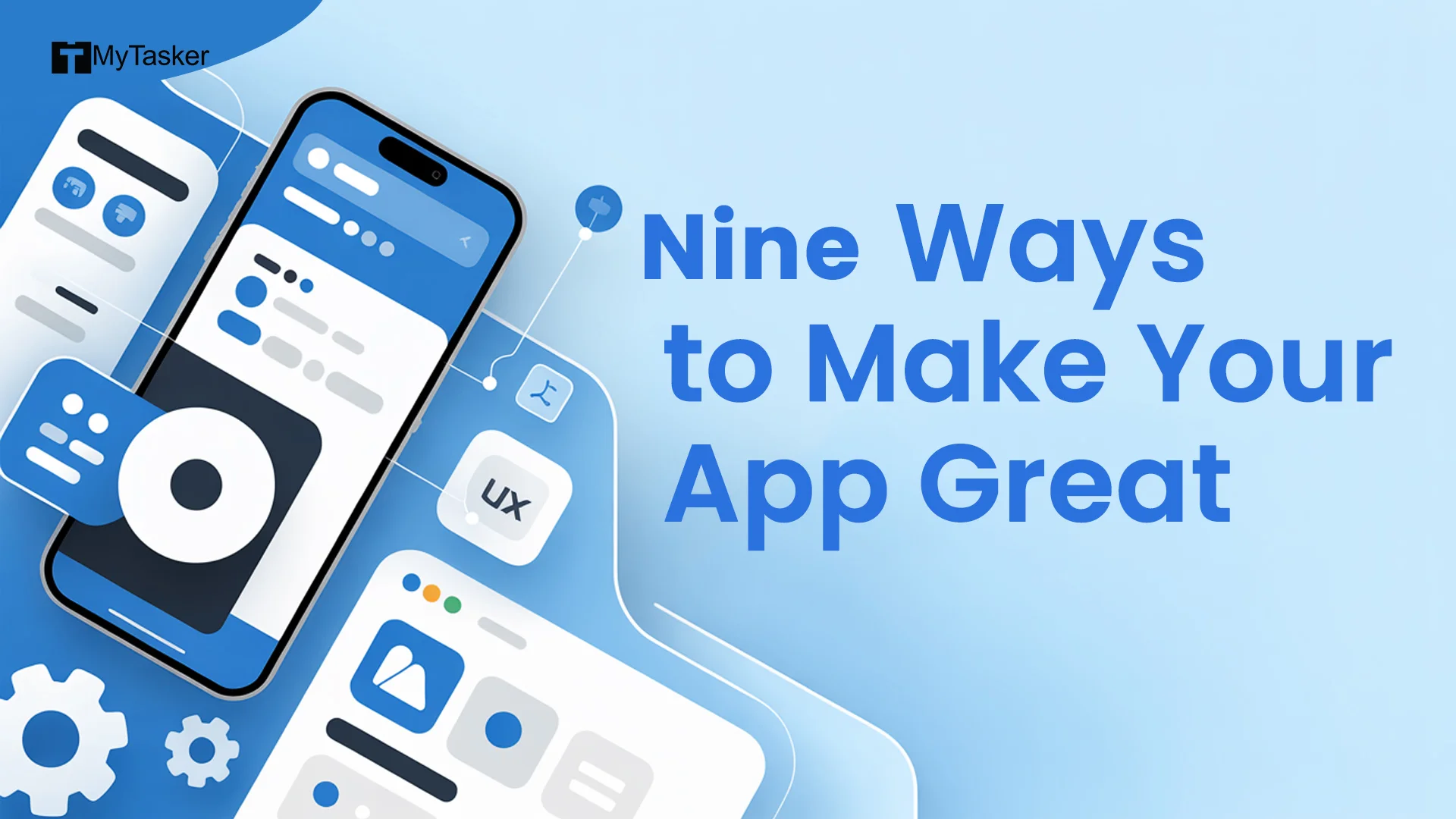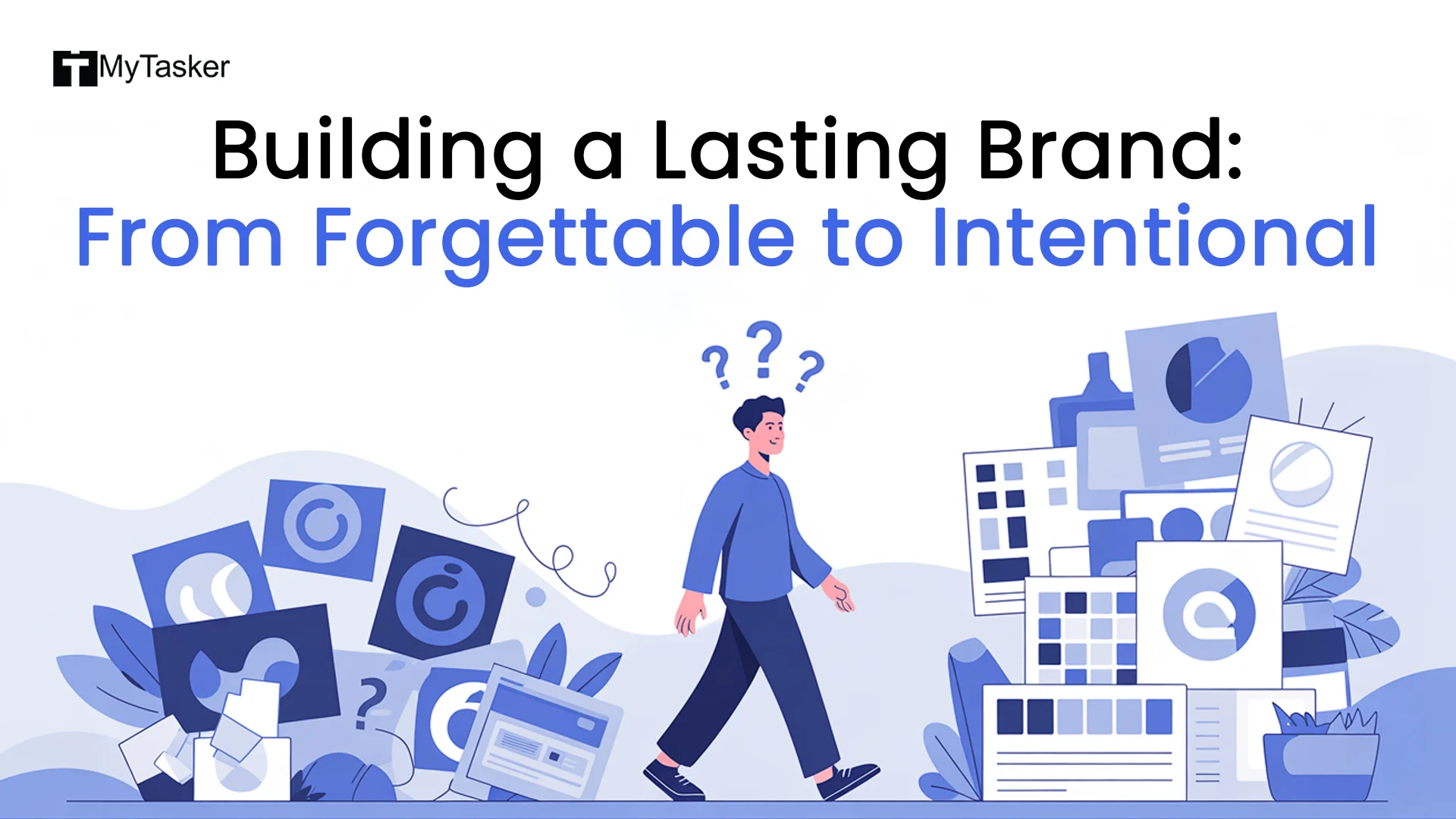I am sure you will agree with me on this:
It is painful for an author when his hard-work goes unnoticed, and readers completely ignore the effort that went into writing the article by going off the page in a mere span of 2 seconds.
It hurts, right?
Wouldn’t it be great if every person just could not help but remain engrossed while reading your article?
I am sure it will be amazing for you if I tell you that following some easy steps will give you exactly what you were looking for all this while.
Readers Attention!
Today, readers not only want to be educated or enlightened by reading your article; they want to be entertained.
The Simplest way to entertain them is by writing high-quality content.
Remember when you talk to your best friend?
You listen. You ask. You laugh.
What’s the bottom line?
It’s an experience. Not just information.
To make the readers part of your experience, you need to engage them right from the first letter and keep them engaged till the last letter.
How will you build this Engagement with your Readers?
It’s as simple as having a conversation.
Now:
There are quite a few BENEFITS if your Reader is listening to you:
- You drive more traffic to your page/content/website
- You position yourself as a good SPEAKER (not WRITER: remember? You are talking)
- It improves the one-to-one relationship between your readers and you.
- As the Readers have vested their confidence in you, it gives you a more prominent voice.
Want to know the best part of Engaging Your Readers?
They keep coming back to hear you speak. They crave for your next post. And the next one.
Let me show you the 20 fundamental ways which are decisive and easy-to-implement on How to Write an Engaging Article which will not bore your readers at any point of time.

1. The Rule of One
If you are thinking that sharing one idea with your readers would be dull; to engage them you need to share all kinds of great ideas, YOU are absolutely WRONG!
You are talking your readers’ ears off. There is nothing more boring than a story that goes in twenty different directions.
Each article should have ONE and only ONE Big Idea.
Each argument, each story, and each example should support it.
Not sure?
Look for the popular blogs on the internet. All of them have one thing in common:
-
Each Headline focuses on ONE concept
-
Each post concentrates on ONE idea
-
Each post encourages you with ONE call to action
Let’s look at a few blogs on the Internet:
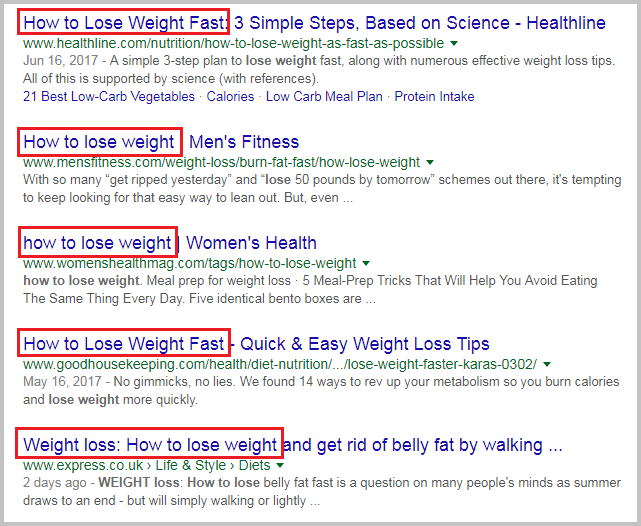
When we searched “how to lose weight”, all the results that Google shows, talk only about “How to Lose Weight” SPECIFICALLY.
Always remember being a blabbermouth is probably more dull than having nothing interesting to say. Avoid unnecessary details to keep your readers engaged and interested.
2. Master the Opening Line
The millisecond a reader hits your page, he is likely to leave the page.
So, Hit them Fast. Hit them hard. With a STRONG INTRODUCTION.
The sole purpose of the first sentence is to entice the Readers so that they read the next sentence.
A well-proven tactic to start creating an Engaging Content:
-
Ask a thought-provoking question: Do you know what an article and a pizza have in common?
-
Open with a quote: "One day, I will find the right words, and they will be simple.”
-
Use Statistics: According to a recently conducted survey, 99.9% of writers experience writer's block.
-
Tell a Story: Charles Waltz was a cardiac surgeon in the 1940s when he began noticing a strange pattern among his patients.
See How Neil Patel write the opening lines of one of his Blog:
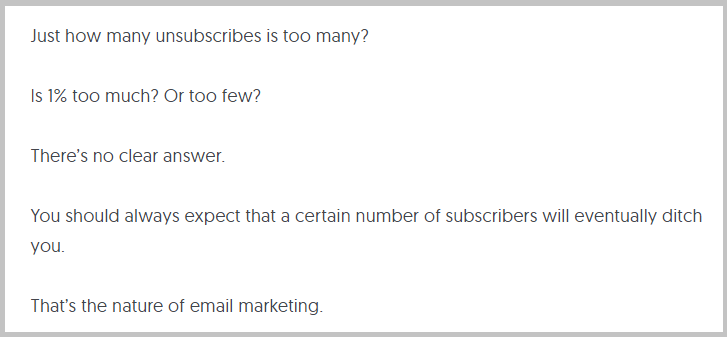
3. Less is More
Long sentences are cumbersome and boring- if difficult words come into them, they become spiritless.
-
Short Words
-
Short Sentences
-
Short Paragraphs
They are easy to read and digest, lively, and entertaining.
Readers are fickle, and they will move on if they are faced with content which are hard to follow.
Let’s look at the Quick Sprout blog:
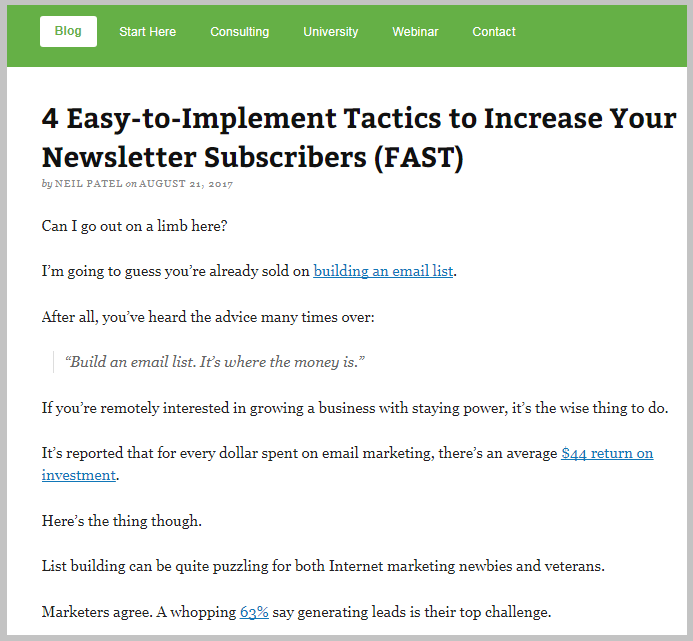
See how the Professionals are big fans of the “Shorts.”
Break your posts with subheads and bullet points to keep your readers interested. Avoid unnecessary details to ensure the content remains clear and engaging.
4. Use Comforting Words
Please don't bore your Readers with difficult words.
Scrap jargon, cut scientific words, and replace long words with short ones.
Plain, simple English helps your Readers to comprehend your message.
Remember these simple things:
-
Complex language doesn't make you look more intelligent.
-
Formality is tiring. So, don't worry about your English teachers, and start pleasing your readers. Start a sentence with because, and, or, but.
-
Use contractions to strike a conversational tone.
Your Readers like to be lazy.
Please don't exhaust them.
They are not interested in learning your extensive vocabulary.
Just help them solve their problems.
5. Stop being Cold-Hearted
You are a human being with fluctuating emotions. Why stop your Readers from feeling them?
Who likes to interact with indifferent and dispassionate people?
Nobody.
Bring in the personal element to your writing. Don't have an ostrich-like approach.
Now:
Here are a few suggestions that will help you to engage your Readers:
-
Choose a topic that you are passionate about
-
Write as if you are talking to your friend
-
Show your readers the ways in which you are like them
-
Vividly describe your stories
-
Metaphors and sarcasm are two important tools
-
Don't be afraid of strong opinions
-
Avoid passive tone
Readers have clicked on your post because they have some doubts and are faced with some real problems.
They want direct solutions, not any diplomatic approach.
The bottom line is:
Show your readers that you are one of them and faced with similar difficulties.
And show them how to solve the problem.
6. Stop being Predictable: Be Vulnerable
A recent case study concluded that only 50% of the Readers actually go through an entire post.
Do you know why?
Because you are too predictable.
Don't undermine the intelligence of your Readers. They have access to millions of posts that sound exactly like yours.
No matter how much you shout for your own post, your predictability is choking your voice.
Instead:
Try to be Vulnerable.
Think:
Are your friends perfect?
Of course not.
We are all imperfect.
As Salvador Dali rightly said, “Have no fear of perfection—you'll never reach it.”
So, go for your weakness, your worries, your fears, and what you think rather than using an overused, predictable phrase.
Fire up your Readers with your vulnerabilities.
7. No need to be Long-Winded
Do avoid the subtle signs of tiresome wordiness. Avoiding unnecessary details is crucial to keep the content engaging and maintain the reader's interest.
Here is what you need to avoid:
-
Redundant Adverbs and Adjectives:
When an adverb or an adjective is not adding any meaning, or it's not helping you to portray your story any better, and, more importantly, if it's not conveying an emotion—then simply CUT It.
-
Excessive Words:
If you can scrap a word without changing the actual meaning of your sentence, go ahead and skip it.
Wearisome words that often can be cut are- in my opinion- that, just, actually, truly, and very.
-
Abstract Nouns: Don't add unnecessary complexity.
For Example, don't write, “This blog topic is of a complex nature.” Just write, “This topic is complex.”
Simply recount your own experiences as simply as you can.
8. Please don't be a Despicable Salesman
You know what makes a salesman pushy, don’t you?
Avoid being uninteresting and tiresome.
These are some irritating and novice mistakes you need to avoid
-
Stop rambling on about your subject/topic.
The Readers are looking for solutions that they are going to get after reading your post on your chosen topic.
If your subject is a Disease, Readers are looking for the Remedies.
No point in telling them more and more about the Disease itself.
Show the BENEFITS to your Readers.
-
Don’t waffle about irrelevant facts.
Avoiding unnecessary details is crucial to keep your readers engaged and interested.
You certainly don’t feel elated when pointless facts are thrown at you.
You feel bored.
Understand your Readers. They are no different.
Think about what keeps them awake at 3 in the morning.
-
The most effective sales tool is Education. Use it liberally.
Educate your Readers about the subject. Tell them what they should do, how should they do and why should they do?
Teaching is the best alternative to sleazy sales.
9. Appeal to All the Senses
When you talk face-to-face with someone, you use intonation and body language to express your feelings.
But:
In a blog post/article, you only have words to attract attention and convey emotion.
That's why you need to turn up your passion and use your words wisely to appeal to the senses of your Readers.
A sensory experience is memorable. A sensory writing is the same.
Our brain processes sensory words as if those senses are actually being stimulated.
People will forget what you said, people will forget what you did but they will always remember how you made them feel.
Feelings come from Senses.
Pro tips: Thinking about how to develop quality content?
At MyTasker, we have proficient content writers who would love to make your web articles more engaging through their writing skills.
10. You Need to be Energetic
You know that energy is contagious.
Don't you?
A monotonous voice lulls people to sleep.
Long and undulating sentences soothe your Readers with a comfortable flow.
Short sentences, however, are dynamic. They are abrupt. They awaken your Readers.
To make your writing more alluring, add a dynamic rhythm.
Interrupt long flowing sentences with short bursts of enthusiastic action.
Positive energy will initiate positive reactions!
11. Be Playful
Having a sense of humor makes you more desirable—especially if you make yourself the butt of your jokes.
How do you make your content sound funny?
Make a quick joke?
What if your readers do not find it funny?
You are not a comedian who has been paid to make his audience laugh.
Relax.
The best part is:
You just have to be creative in your own way. Think of unique ways to tell your story or get your point across.
When you talk, no one tells you what to say or how to say.
Be humble. Remember to make people smile.
12. Do Not Commit Crimes Against Readability
You have carefully crafted your content. Your article is informative, friendly, and commanding attention.
But:
Do you know that typographical errors can destroy the effectiveness of your precious words?
Leave alone the “Engaging” factor.
To make your article readable, avoid making stupid typographic mistakes:
Also, keep an eye on the Font of the post:
-
Don't make your font too fancy. They are hard to read.
-
Don't make the font too small. Tiny fonts strain your eyes.
-
Don't choose a font color that is almost similar to your background.
Always use a readable font that doesn't let your Readers drown in dreary blocks of text.
Be generous with White Space:
-
Frame your text with white space
-
Reduce your content width
-
Add extra white space around subheadings
Do you know how your article bore your Readers to tears?
Characterless cliched photos. They make your content drab.
13. “A Picture is Worth a Thousand Words”
Do you know that something as easy as adding Images to your Blog post would increase your readers, followers, subscribers, and leads?
If you know it, then why don't you do it?
Here is the kicker for you:
According to several industry studies, articles with images get a lot more views than articles without images.
There is no rocket science in knowing that human brains process images or any form of Multimedia better than texts.
But be a little careful.
Including lots of images doesn't have an impact on search engine ranking.
So, choose a few relevant multi-media elements like images, videos, charts, infographics, etc.
You might wonder:
“How many images should I have in my post?”
I would suggest you use as many images as you need in order to communicate your concepts clearly.
Pro tips: Want to make your content look visually charming?
At MyTasker, we have talented web designers who can serve your purpose by utilizing well-designed infographics.
14. Tell Interesting Stories
Why do you enjoy having a chat with your best friends or your favorite colleagues?
Because you love sharing small stories.
You might discuss a movie that you went to yesterday or a referee's decision in Sunday's match.
Your friends can talk about more than their specialty subject.
If your blog post/article discusses only your topic of expertise, you show yourself as one-dimensional person with a specific area of interest.
By sharing tidbits about your hobbies or personal life, you become a more interesting person.
When you draw analogies from personal experience, you give your readers a glimpse into your life.
They get a feeling that they know you. And that's how you start to bond.
15. Let Your Readers Fill in the Gaps for Themselves
Your Readers are independent thinkers.
They like to make up their own minds. So, allow them to draw their own conclusions.
For Example, I can tell you, “I am a rebel”
But:
You'd probably think, “yeah yeah that's what he likes to think”
This is why it's better to give the facts and let your readers draw their own conclusions.
For instance:
-
My high school teacher told me to study physics in college, but at the age of 17, I left my home to learn Chinese.
-
Rather than choosing a safe color like blue for my website, I went for purple and orange—to be different and stand out.
Each of these statements paint a picture of who I am as a person—allowing you, as Reader, to make up your own mind about me.
16. Don't be Too Professional
When given a choice, what would you rather do?
Hang out with your friends or attend a social gathering of elderly people?
I think the choice is pretty obvious.
Now:
The reason you chose your friends is simply because you love their company.
And the very reason you like their company is because you enjoy the casual atmosphere, their comforting communication tone and mainly because none of them lectures you in a professional authoritative tone.
Right?
Then why on earth would you write something in a tone that makes you inevitably a person from the hierarchy?
If you talk in a tone that does not resonate with the people you have written the article for, you will soon be forgotten.
Why?
Because using an authoritative tone shows that you have considered your readers' knowledge to be limited.
And you have made them feel subordinate to you.
If you hate the person who has ever made you feel inferior to him or her, why do you expect a reader to come back to you or even remember you when you speak like a boss?
Remember:
Phrases like “you should” and “you need” SHOULD be strictly avoided.
Instead, use “Why not” or “Let's try this” or “Don't you think…”
Using a compassionate tone makes readers feel you are talking from your heart and you actually mean what you say.
They can connect to you much more easily.
Stop being a professional preacher, but try to be an eloquent speaker.
17. Bring Unexpected Gifts
You listen well, you ask questions, and you give your readers space to breathe.
But:
Sometimes Engagement requires a little more, doesn't it?
Readers like to know you care about them and there is no better way to show you care than by bringing a gift.
Sometimes, give away a free cheat sheet or an e-book that's seriously useful to your readers.
Have a look at Robbie Richards's blog:

18. Don't Doubt Yourself
Doubting yourself as an author is similar to committing suicide.
All of us have days when writing a single word takes a monumental effort.
And you hate the sight of a blank page on your screen.
Well, the best part is:
This is actually the best time to take a break.
Take a stroll in the park. Or simply sit and relax.
Don't worry about an Engaging article. Engage with yourself. With your friends.
And one thing more:
Don't use the phrase “In my opinion” too much. Your readers already know that this is your opinion.
There is no point in speaking that way as it screams uncertainty when you cast doubt on the readers' minds about the content you are presenting.
YOU are the EXPERT. Don't forget.
19. Self-edit to Boost Charisma
When you eat, you eat. When you sleep, you sleep.
Right?
So, don't worry about captivating your readers when you are writing.
Don't interrupt your flow.
Worry about being delightful, entertaining, and engaging only when editing.
These tips will help you add life to your dull, drab content:
-
Check your Engagement level
Don't be a boastful ego-tripper. How often have you used the words you and your? Use the WeWe Calculator to measure enchantment.
-
Increase the number of really good bullet points.
Short and to-the-point lists are more exciting than lackluster, solid paragraphs.
-
Examine your Paragraph length.
Aim for a maximum of five sentences per paragraph. Endless paragraphs are mind-numbingly tiring.
-
Calculate the average number of words per sentence
Try to have fewer than ten words per sentence. Cut long sentences into two and scrap redundant words.
-
Boost your content with trigger words
Make your texts livelier by including vivid and emotional words.
And if you edit your text only once, increase the number of drafts you write. You will be amazed how quickly this can make a boring content more appealing and engaging.
20. Create Something Enjoyable
You don’t watch a movie or read a book if you feel exhausted.
Nobody does.
So, create something enjoyable.
When your Reader is reading something, they should enjoy it first.
Your Reader should feel refreshed by reading all the information you have provided them.
The Reader should know where they are headed and, in the end, how they got there.
The ride should be fascinating and enjoyable.
Three equally essential Bonus Tips (addition)
21. Understanding Your Audience
Understanding your audience is the cornerstone of creating content that truly resonates. Imagine trying to have a conversation with someone without knowing anything about them—awkward, right? The same goes for writing. To keep your readers engaged, you need to know who they are, what they care about, and what they hope to gain from your content.
Here are some tips to help you get to know your target audience better:
-
Conduct Market Research: Identify your target audience and their demographics. Who are they? What do they do? What are their interests?
-
Analyze Website Analytics: Dive into your website analytics to see who’s visiting your site and what they’re interested in. This data is a goldmine for understanding your readers.
-
Engage on Social Media: Social media is a fantastic tool for gauging your audience’s interests and concerns. Pay attention to what they’re talking about and what content they’re engaging with.
-
Use Surveys and Feedback Forms: Direct feedback is invaluable. Ask your audience about their needs and preferences through surveys and feedback forms.
By understanding your target audience, you can tailor your content to their needs and preferences, making it more engaging and relevant. This connection will keep your readers invested in what you have to say.
22. Encouraging Interaction and Feedback
Building a loyal and engaged community around your content is all about interaction and feedback. Think of it as a two-way street—your readers want to feel heard and valued. Here’s how you can encourage that interaction:
-
Ask Thought-Provoking Questions: End your blog posts with questions that spark discussion and debate. This invites your readers to share their thoughts and engage with your content.
-
Engage on Social Media: Use social media platforms to interact with your audience. Respond to their comments and messages promptly to show that you value their input.
-
Email Newsletters: Use your newsletters to ask for feedback and encourage subscribers to share their opinions. This not only boosts engagement but also provides you with valuable insights.
-
Surveys and Feedback Forms: Regularly gather information about your audience’s needs and preferences through surveys and feedback forms.
-
Personalized Responses: Always respond to comments and messages in a timely and personalized manner. This shows your readers that you genuinely care about their feedback.
By fostering interaction and feedback, you create a sense of community and investment among your readers, which significantly boosts reader engagement.
23. Measuring and Improving Engagement
Engagement isn’t a one-time achievement; it’s an ongoing process that requires continuous monitoring and improvement. Here’s how you can measure and enhance your reader engagement:
-
Analytics Tools: Use tools like Google Analytics to track key engagement metrics such as page views, bounce rate, and time on site. These metrics give you a clear picture of how your content is performing.
-
Social Media Metrics: Monitor likes, shares, and comments on your social media posts to see how your audience is interacting with your content.
-
Email Marketing Metrics: Pay attention to open rates, click-through rates, and conversion rates in your email campaigns. These metrics reveal how your audience is responding to your emails.
-
Regular Surveys: Conduct surveys and feedback forms regularly to gather insights into your audience’s needs and preferences.
-
A/B Testing: Experiment with different content formats, headlines, and calls to action to see what resonates best with your audience. A/B testing helps you refine your strategy based on real data.
By continuously measuring and improving engagement, you can fine-tune your content strategy to better resonate with your audience, keeping them engaged and driving better results for your business.
Will Avoiding the Pitfalls and Doing What's Necessary Help You Build an Audience?
The Gospel Truth:
There are no strict guidelines that will show you how to be Engaging.
No blueprint will tell you how to write an engaging article or a blog post.
No codes exist to keep your readers glued to your content and never get bored.
But:
You can always avoid making common and silly mistakes.
Be disciplined. Write with passion. And edit rigorously.
Display your enthusiasm to entertain your Readers.
If you even break a few rules (including these) do it with passion. You will receive love from your audience.
There you have it.
By now, you are probably excited to write your next post.
I am, too.
Now, we want to hear from you:
Do you know any other strategies that have helped you engage your readers?
Or, maybe you have some questions to ask.
Feel free to write it in the Comment section below!
Have you been already writing articles that are not driving the desired number of eyeballs to it?
At MyTasker we have a dedicated Writing Team that can write Engaging Articles on your behalf that will save you a lot of time from your busy schedule and will help you get the result that you deserve.



.jpg)



